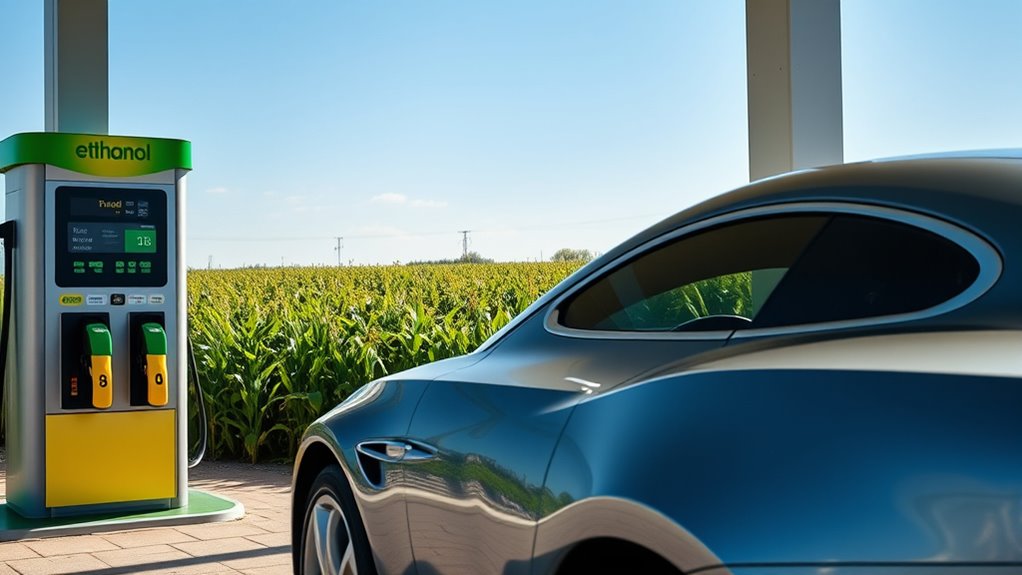Ethanol fuels are renewable and emit less greenhouse gases than gasoline, making them a cleaner option. However, producing ethanol from crops like corn can lead to land use change, habitat loss, and high water and fertilizer use. Scaling up poses economic and logistical challenges, and some argue that emissions savings aren’t as significant as they seem. To understand how these pros and cons balance out and what future developments might mean, keep exploring this complex topic.
Key Takeaways
- Ethanol reduces greenhouse gas emissions compared to gasoline but may be offset by farming-related emissions.
- Producing ethanol from crops requires significant land, water, and energy, raising environmental and resource concerns.
- Large-scale ethanol production can lead to habitat loss, deforestation, and competition with food crops.
- Advances in sustainable farming and alternative sources like cellulosic biomass can improve ethanol’s environmental impact.
- Economic and logistical challenges limit widespread adoption despite potential climate benefits.

Have you ever wondered how ethanol fuels are changing the way we power our vehicles? As more drivers seek alternatives to traditional gasoline, ethanol has become a popular option because it’s often seen as a cleaner, renewable energy source. However, understanding its environmental impact and production challenges reveals a more complex picture. Ethanol is made primarily from crops like corn or sugarcane, which means its environmental footprint depends heavily on how those crops are grown and processed. For instance, large-scale corn farming can lead to significant land use changes, water consumption, and fertilizer runoff, all of which can harm local ecosystems. This environmental impact raises questions about whether ethanol truly reduces pollution or simply shifts it elsewhere. Additionally, producing ethanol on a large scale requires considerable resources—land, water, and energy—making it a potentially resource-intensive process. These production challenges can sometimes offset the environmental benefits that ethanol promises, especially when considering the energy used in cultivation, harvesting, and conversion. Furthermore, the debate around whether ethanol reduces greenhouse gas emissions compared to gasoline is ongoing. While burning ethanol releases less carbon dioxide per unit, the associated farming practices and energy inputs may diminish its overall environmental advantage. You might also consider the fact that converting land for crop production can contribute to deforestation or habitat loss, further complicating ethanol’s environmental credentials. On the other hand, proponents argue that advances in agricultural technology and sustainable farming practices can mitigate some of these issues. They point out that ethanol, particularly when produced from waste biomass or cellulosic sources, has the potential to lower carbon emissions substantially. Additionally, the development of sustainable farming practices can help reduce the environmental footprint of ethanol production. Still, the current production methods often face hurdles like crop yields, economic viability, and logistical constraints, which can hinder widespread adoption. These production challenges mean that scaling ethanol as a primary fuel source isn’t straightforward; it involves balancing environmental concerns with economic and logistical realities. Overall, while ethanol fuels offer promising benefits as a renewable energy source, understanding the environmental impact and production challenges helps you see the full picture. It’s not just about replacing gasoline—it’s about weighing the benefits against the costs and figuring out how best to develop sustainable, efficient ways to produce and use ethanol. As technology advances and practices improve, ethanol could become a more environmentally friendly alternative, but for now, it remains a complex solution with both potential and pitfalls.
Frequently Asked Questions
How Does Ethanol Production Impact Water Resources?
Ethanol production impacts water resources by causing water contamination through runoff containing chemicals and fertilizers used in crops. It also contributes to resource depletion, as large amounts of water are needed for crop irrigation and processing. You might notice that increased water use can strain local supplies, and contamination risks harm ecosystems. Managing water efficiently and reducing runoff can help mitigate these effects and protect your water resources.
Are Ethanol Fuels Compatible With All Vehicle Types?
Ethanol fuels aren’t compatible with all vehicle types, especially older models not designed for higher ethanol blends. While newer vehicles often handle E10 or E85 without issues, engine performance can decline in some engines not calibrated for ethanol. You should check your vehicle’s compatibility to avoid damage or reduced efficiency. Using the right fuel guarantees peak engine performance and helps prevent costly repairs.
What Are the Long-Term Effects of Ethanol on Engine Durability?
You might notice that long-term ethanol use can cause engine corrosion if your vehicle isn’t designed for it, potentially reducing durability. Ethanol can also impact fuel efficiency, leading to slightly lower mileage over time. To protect your engine, make certain your vehicle is compatible with ethanol-blended fuels and perform regular maintenance. Doing so helps minimize corrosion risks and keeps your engine running smoothly for years.
How Does Ethanol Fuel Affect Greenhouse Gas Emissions Compared to Gasoline?
Imagine a cleaner sky as you burn ethanol instead of gasoline. Ethanol fuel reduces your carbon footprint by emitting fewer greenhouse gases, helping with emission reduction efforts. When you choose ethanol, you cut down on carbon dioxide and other pollutants that contribute to climate change. This eco-friendly alternative makes a visible difference, turning your drive into a step toward a healthier planet, with less environmental impact than traditional gasoline.
Can Ethanol Be Sustainably Produced From All Feedstocks?
You can produce ethanol sustainably from a variety of feedstocks, thanks to feedstock diversity. Using diverse raw materials like corn, sugarcane, or agricultural waste helps improve production scalability and reduces environmental impact. However, not all feedstocks are equally sustainable, as some may compete with food production or cause deforestation. To guarantee sustainability, it’s vital to select feedstocks wisely and develop scalable methods that minimize ecological and social costs.
Conclusion
You should consider both the benefits and drawbacks of ethanol fuels. They can reduce greenhouse gas emissions by up to 39% compared to gasoline, making them a greener option. However, their production may lead to increased food prices and land use concerns. Ultimately, switching to ethanol fuels can be part of a cleaner energy future, but it’s essential to weigh these environmental benefits against potential societal impacts to make informed decisions.









